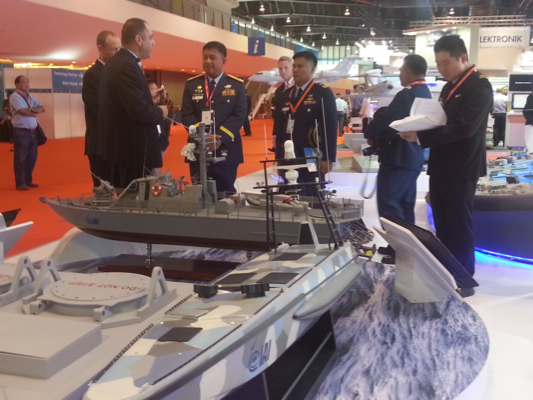Australia’s Chief of Navy has spoken out against China’s controversial land reclamation projects on disputed islands in the South China Sea. Speaking in Singapore at the International Maritime Security Conference (IMSC), Vice Admiral Tim Barrett also reaffirmed Australia’s commitment to regional security and outlined the part the Royal Australian Navy can play in regional maritime cooperation.
Mike Yeo | Singapore
At the IMSC, which was held in May as part of the 10th iteration of the International Maritime and Defence Exposition Asia (IMDEX Asia), VADM Barrett also warned that despite the closer economic ties between countries in the Asia-Pacific, that “does not necessarily rule out the possibility of strategic competition and with it, conflict.” Citing the example of Europe in 1914, VADM Barrett noted that the close economic ties between the various business communities quickly unravelled once the battle was joined.
In the region, VADM Barrett acknowledged the benefits that China’s phenomenal economic growth over the past decades has delivered to the globe, including Australia, and that the recent growth in defence spending was a natural progression as nations seek to protect their interests. However, he expressed Australian concerns about the recent developments in South and East China Seas, adding that “land reclamation activity by any claimant raises tensions in the region, and Australia opposes the use of intimidation, aggression or coercion by any claimant state.”
"This year’s IMDEX saw 20 warships from 13 different countries participating in the Warships Display at Singapore’s Changi Naval Base."
As such, Australia views regional and multilateral security frameworks such as the ASEAN (Association of South East Asian Nations) Regional Forum and Indian Navy Naval Symposium (IONS) as critical strategic assets and VADM Barrett urged all parties make use of existing forums to resolve these matters peacefully and in accordance with international law. Australia’s engagement in this architecture reflects how important the security and stability of the region is to its national security, and successive Australian governments understand the Australian Defence Force’s engagement in the region can add to regional security by its presence.
The addition of two Canberra-class Landing Helicopter Docks (LHDs) to the RAN’s fleet in the near future is an important component to modernizing and updating the RAN’s naval capabilities. VADM Barrett notes that the LHDs offer considerable opportunities to contribute to regional maritime cooperation, providing the ADF with a significant leap in amphibious capability and capacity to contribute to regional stability through joint Exercises.
As multi-role platforms, the LHDs will also give the ADF strategic options for graduated response to events and the ability to provide an Australian presence in the region. The Canberra-class LHDs also represent a significant improvement in Australia’s ability to perform Humanitarian Assistance and Disaster Relief in terms of personnel Aust can lift in the ship and in quantity of stores carried.
VADM Barrett also added that the LHDs can provide Joint Command and Control (C2) during relief missions. IMDEX host nation Singapore is also seeking a similar ship partially for similar reasons, with Defence Minister Ng Eng Hen having previously revealed a requirement for a larger Joint Multi-Mission ship for the Republic of Singapore Navy (RSN) to replace four 141-metre Endurance-class Landing Platform Docks by 2030.
This year’s IMDEX saw 20 warships from 13 different countries participating in the Warships Display at Singapore’s Changi Naval Base. Australia was represented by the Anzac-class frigate HMAS Perth (FFH-157), which had just finished its participation in this year’s Five Power Defence Arrangement (FPDA) Exercise Bersama Lima in the South China Sea with ships from the navies of NZ, Malaysia and Singapore.

Perth is in the midst of a three-month deployment to South East Asian waters and Australia’s North West Shelf. After IMDEX she will participate in 5th Western Pacific Naval Symposium Multi-Lateral Sea Exercise (WMSX) with 16 ships from the navies of ten nations including Singapore, Malaysia, Thailand, Indonesia and China. These exercises, conducted from 18 to 22 May 2015, seek to strengthen the information-sharing process and enhance interoperability at sea among the participating navies and maritime agencies.
The participants will be tasked to undertake a spectrum of maritime security operations such as exercise planning, shore boarding, maritime interdiction as well as search and rescue operations in the waters off Singapore. As Major Dewayne Wan, Commanding Officer of the RSN Patrol Vessel RSS Justice, explained, “Maritime security threats are trans-boundary in nature and the opportunity to participate in WMSX to foster cooperation and strengthen interoperability at sea with the different nations’ navies is an important step to overcoming this threat.”
Following its South East Asian sojourn, HMAS Perth will return to Australian waters in June, and will participate in Exercise Talisman Sabre and a patrol of Australia’s North West Shelf before returning to Fleet Base West in July.



